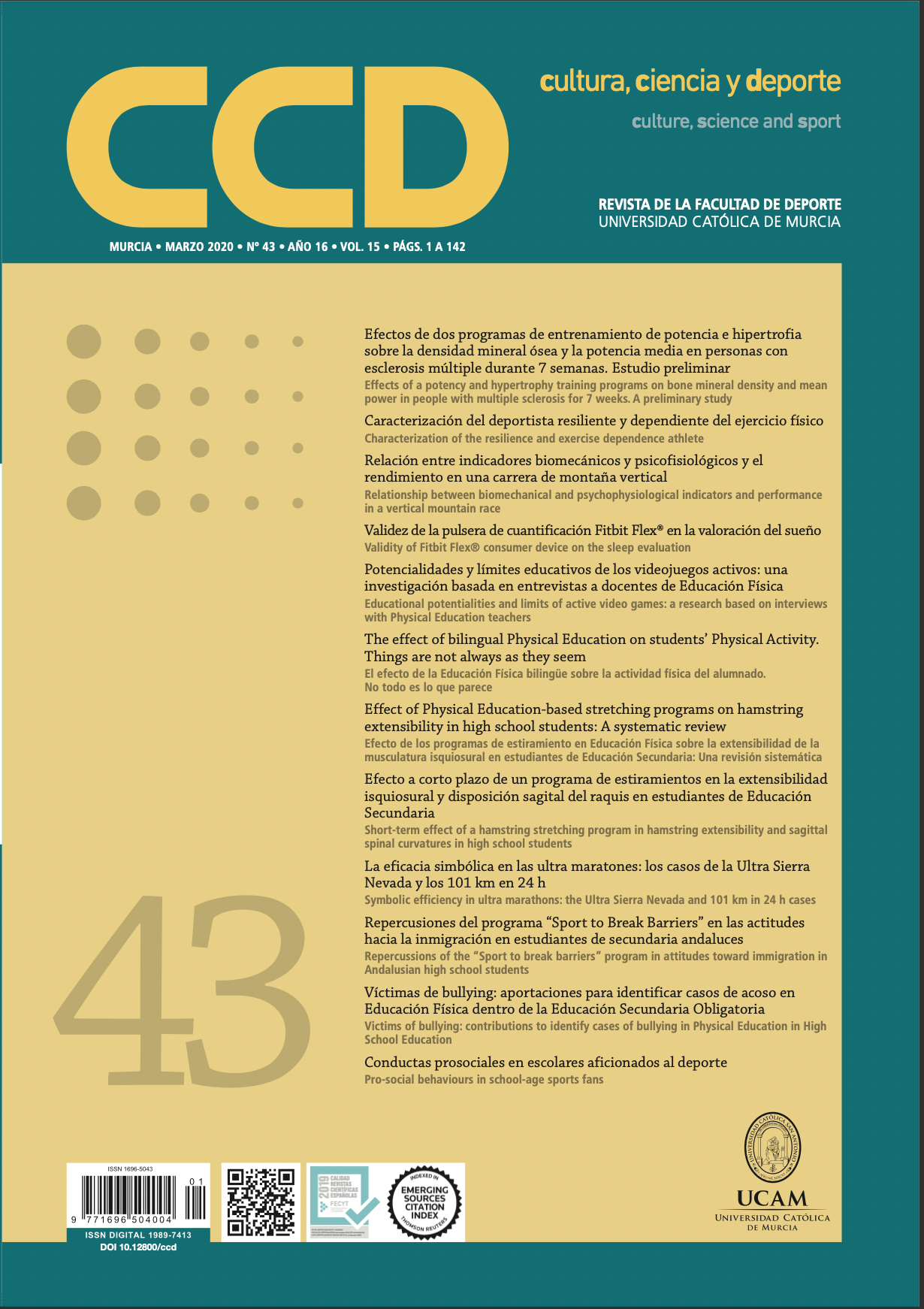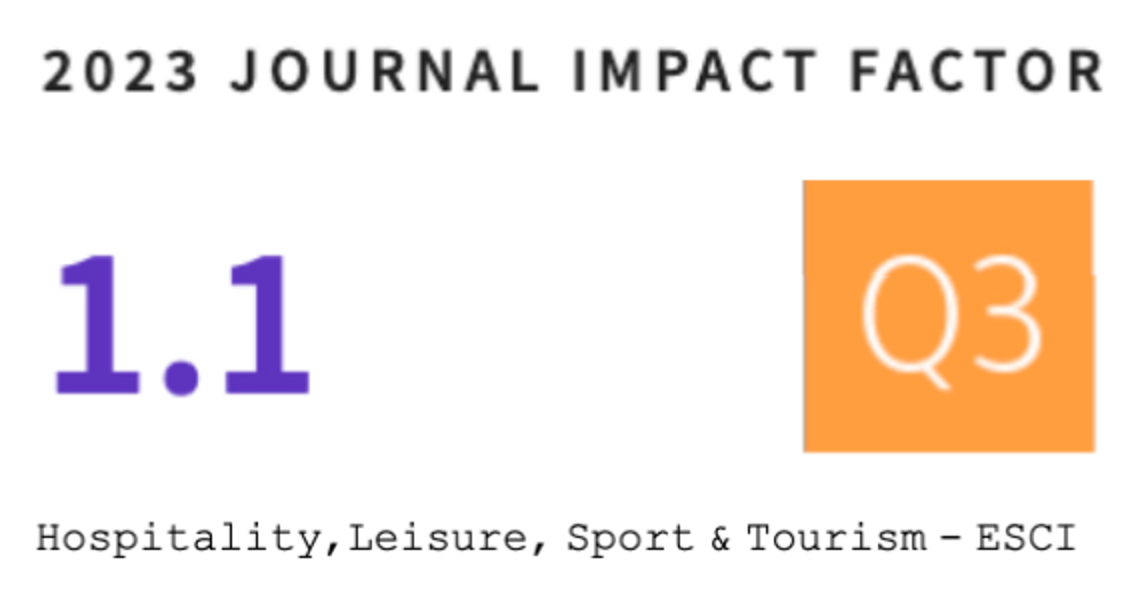Efecto a corto plazo de un programa de estiramientos en la extensibilidad isquiosural y disposición sagital del raquis en estudiantes de Educación Secundaria.(Short-term effect of a hamstring stretching program in hamstring extensibility and sagittal spinal curvatures in high school students).
DOI:
https://doi.org/10.12800/ccd.v15i43.1401Keywords:
Flexibilidad, estiramiento muscular, Educación Física, postura raquídeaAbstract
Debido a la frecuencia de casos con una reducida extensibilidad isquiosural y alteraciones posturales en adolescentes, el objetivo de este estudio fue analizar la influencia de un programa de estiramientos, de corta duración, en la extensibilidad isquiosural y disposición sagital del raquis en estudiantes de Educación Secundaria. A sesenta y dos adolescentes varones (14-17 años) se les midió la extensibilidad isquiosural (test sit-and-reach y test de elevación de la pierna recta) antes (pre-test) y después (post-test) de un programa escolar de 5 semanas (2 sesiones semanales), compuesto por tres estiramientos de la musculatura isquiosural, con una duración total por sesión de 70 segundos. También se valoró la disposición sagital del raquis torácico, lumbar e inclinación pélvica en bipedestación relajada y en el sit-and-reach. Se encontró un aumento significativo en la distancia alcanzada en el test sit-and-reach (d= 0,23) y en el ángulo de flexión coxofemoral en el test de elevación de la pierna recta (d= 0,85-0,90). La disposición sagital del raquis en bipedestación no mostró diferencias entre el pre- y post-test. En la posición de máxima flexión del sit-and-reach, hubo una menor cifosis torácica y menor retroversión pélvica (p < 0,05) en el post-test, aunque con un tamaño del efecto bajo (d=0,02-0,22). Un programa de estiramientos de la musculatura isquiosural realizado en las dos clases semanales de Educación Física (70 segundos de estiramiento en cada clase), durante 5 semanas, mejora la extensibilidad isquiosural de adolescentes y reduce, ligeramente, la flexión torácica y la retroversión pélvica en la posición de máxima flexión del tronco con rodillas extendidas.
===
Hamstring shortness and postural deformities are frequent in adolescents. For this reason, the purpose of this study was to analyse the influence of a shortterm stretching program in hamstring extensibility and sagittal spinal curvatures in high school students. Sixty-two male high school students aged 14-17 years old performed a 70 seconds hamstring stretching program (3 exercises) twice a week for five weeks during their physical education classes. Hamstring extensibility was measured by the straight leg raise test and sit-and-reach test. Thoracic and lumbar curves and pelvic inclination were measures in relaxed standing and in the sit-and-reach test. These measures were assessed before (pre-test) and after (post-test) the intervention program. Significant increases in the sit-and-reach score (d= 0.23) and in the straight leg raise angle (d= 0.85-0.90) were found. Sagittal spinal curvatures in standing showed no differences between pre- and post-test. In the maximal trunk flexion position during the sit-and-reach was detected a lower thoracic kyphosis and posterior pelvic tilt (p < 0.05) in post-test although with a low size effect (d=0.02-0.22). A hamstring muscle stretching program with a volume of 2 sessions per week (70 seconds each session), for 5 weeks, improves hamstring extensibility in adolescents and slightly reduces the thoracic bending and posterior pelvic tilt in trunk flexion postures with extended knees.
References
Andújar, P., Santonja, F., García de la Rubia, S., & Rodríguez, P. L. (1999). Higiene postural del escolar: Influencia de la Educación Física. Pediatría Integral, 2, 135-142.
Becerra-Fernández, C. A., Mayorga-Vega, D., & Merino-Marban, R. (2017). How do students’ hamstring extensibility levels change through an academic year? A longitudinal study. Educación Física y Ciencia, 19(2), e029. doi: https://doi.org/10.24215/23142561e029
Bohajar-Lax, A., Vaquero-Cristóbal, R., Espejo-Antúnez, L., & LópezMiñarro, P. A. (2015). Efecto de un programa de estiramiento de la musculatura isquiosural sobre la extensibilidad isquiosural en escolares adolescentes: influencia de la distribución semanal de las sesiones. Nutrición Hospitalaria, 32(3), 1241-1245. doi: 10.3305/nh.2015.32.3.9308
Cabry, J., & Shiple, B. J. (2000). Increasing hamstring flexibility deBIBLIOGRAFÍA creases hamstring injuries in high school athletes. Clinical Journal of Sport Medicine, 10, 311-312. doi: https://doi.org/10.1097/00042752- 200010000-00029
Carregaro, R. L., & Coury, H. J. C. (2009). Does reduced hamstring flexibility affect trunk and pelvic movement strategies during manual handling? International Journal of Industrial Ergonomics, 39, 115-120. doi: https://doi.org/10.1016/j.ergon.2008.05.004
Cohen, J. (1988). Statistical power analysis for the behavioral science. 2nd ed. Hillsdale: Lawrence Erlbaum Associates.
Cohen, L., Kobayashi, S., Simic, M., Dennis, S., Refshauge, K., & Pappas, E. (2017). Non-radiographic methods of measuring global sagittal balance: A systematic review. Scoliosis and Spinal Disorders, 12(1), 1-12. doi: https://doi.org/10.1186/s13013-017-0135-x
Kang, M. H., Jung, D. H., An, D. H., Yoo, W. G., & Oh, J. S. (2013). Acute effects of hamstring-stretching exercises on the kinematics of the lumbar spine and hip during stoop lifting. Journal of Back and Musculoskeletal Rehabilitation, 26(3), 329-336. doi: 10.3233/BMR-130388
Kemmochi, M., Sasaki, S., & Ichimura, S. (2018). Association between reduced trunk flexibility in children and lumbar stress fractures. Journal of Orthopaedics, 15(1), 122-127. doi: org/10.1016/j.jor.2018.01.014.
López-Miñarro, P. A., Ferragut, C., Alacid, F., Yuste, J. L., & García, A. (2008). Validez de los test dedos-planta y dedos-suelo para la valoración de la extensibilidad isquiosural en piragüistas de categoría infantil. Apunts Medicina Deportiva, 157, 24-29. doi: https://doi. org/10.1016/S1886-6581(08)70065-3
López-Miñarro, P. A., Muyor, J. M., & Alacid, F. (2012). Influence of hamstring extensibility on sagittal spinal curvatures and pelvic tilt in high-trained young kayakers. European Journal of Sports Science, 12(6), 469-474. doi: https://doi.org/10.1080/17461391.2011.575 476
López-Miñarro, P. A., Muyor, J. M., Alacid, F., & Rodríguez, P. L. (2011). Influence of sport training on sagittal spinal curvatures. In: Wright AM, Rothenberg SP, editors. Posture: Types, Assessment and Control. New York: Nova Publishers Pub Inc, pp. 63-98.
López-Miñarro, P. A., Muyor, J. M., Belmonte, F., & Alacid, F. (2012). Acute effects of hamstring stretching on sagittal spinal curvatures and pelvic tilt. Journal of Human Kinetics, 31, 69-78. doi: https://doi. org/10.2478/v10078-012-0007-7
López-Miñarro, P. A. & Rodríguez, P. L. (2010). Hamstring muscle extensibility influences the criterion-related validity of sit-and-reach and toe-touch tests. The Journal of Strength and Conditioning Research, 24(4), 1013-1018. doi: 10.1519/JSC.0b013e3181c7c60d
Mannion, A. F., Knecht, K., Balaban, G., Dvorak, J., & Grob, D. (2004). A new skin-surface device for measuring the curvature and global and segmental ranges of motion of the spine: reliability of measurements and comparison with data reviewed from the literature. European Spine Journal, 13(2), 122-136. doi: https://doi.org/10.1007/s00586- 003-0618-8
Mayorga-Vega, D., Merino-Marbán, R., Garrido, F. J., & Viciana, J. (2014a). Comparison between warm-up and cool-down stretching programs on hamstring extensibility gains in primary school children. Physical Activity Review, 1(1), 16-24.
Mayorga-Vega, D., Merino-Marbán, R., & Viciana, J. (2014b). Criterion-related validity of sit-and-reach tests for estimating hamstring and lumbar extensibility: A meta-analysis. Journal of Sports Science Medicine, 13(1), 1-14. Disponible en: https://www.jssm.org/volume13/iss1/cap/jssm-13-1.pdf
Mayorga-Vega, D., Merino-Marban, R., Manzano-Lagunas, J., Blanco, H., & Viciana, J. (2016). Effects of a stretching development and maintenance program on hamstring extensibility in schoolchildren: A cluster-randomized controlled trial. Journal of Sports Science Medicine, 15(1), 65-74. Disponible en: https://www.jssm.org/volume15/iss1/ cap/jssm-15-65.pdf
Mayorga-Vega, D., Merino-Marbán, R., Real, J., & Viciana, J. (2015). A physical education-based stretching program performed once a week also improves hamstring extensibility in school children: a cluster-randomized controlled trial. Nutrición Hospitalaria, 32(4), 1715- 1721. doi: 10.3305/nh.2015.32.4.9302. McGill, S. M. (2002). Low Back Disorders: Evidence based prevention and rehabilitation. Champaign, IL.: Human Kinetics.
Medeiros, D. M., Cini, A., Sbruzzi, G., & Lima, C. S. (2016). Influence of static stretching on hamstring flexibility in healthy young adults: Systematic review and meta-analysis. Physiotherapy Theory and Practise, 32(6), 438-445. doi: https://doi.org/10.1080/09593985.2016.1 204401
Mejia, E. A., Hennrikus, W. L., Schwend, R. M., & Emans, J. B. (1996). A prospective evaluation of idiopathic left thoracic scoliosis with MRI. Journal of Pediatric Orthopaedics, 16(3), 354-358. doi: 10.1097/01241398-199605000-00012
Melrose, D. R., Spaniol, F. J., Bohling, M. E., & Bonnette, R. A. (2007). Physiological and performance characteristics of adolescent club volleyball players. The Journal of Strength and Conditioning Research, 21(2), 481-486. doi: 10.1519/R-19185.1
Nyland, J., Kocabey, Y., & Caborn, D. N. (2004). Sex differences in perceived importance of hamstring stretching among high school athletes. Perceptual and Motor Skills, 99(1), 3-11. doi: https://doi. org/10.2466/pms.99.1.3-11
Fasuyi, F. O., Fabunmi, A. A., & Adegoke, B. O. A. (2014). Hamstring muscle length and pelvic tilt range among individuals with and without low back pain. Journal of Bodywork and Movement Therapies, 21(2), 246-250. doi: 10.1016/j.jbmt.2016.06.002.
Post, R. B., & Leferink, V. J. (2004). Spinal mobility: sagittal range of motion measured with the SpinalMouse, a new non-invasive device. Archives of Orthopaedic and Trauma Surgery, 124(3), 187-192. doi: https://doi.org/10.1007/s00402-004-0641-1
Rodríguez, P. L., Santonja, F. M., López-Miñarro, P. A., Sainz de Baranda, P., & Yuste, J. L. (2008). Effect of physical education stretching programme on sit-and-reach score in schoolchildren. Science & Sports, 23(3-4), 170-175. doi: 10.1016/j.scispo.2007.12.013
Sainz de Baranda, P. (2009). El trabajo de la flexibilidad en educación física: Programa de intervención. Cultura, Ciencia y Deporte, 4, 33-38. doi: http://dx.doi.org/10.12800/ccd.v4i10.129
Santonja, F. M., Sáinz de Baranda, P., Rodríguez, P. L., López-Miñarro, P. A., & Canteras, M. (2007). Effects of frequency of static stretching on straight-leg raise in elementary school children. The Journal of Sports Medicine and Physical Fitness, 47(3), 304-308.
Takahashi, I., Kikuchi, S., Sato, K., & Sato, N. (2006). Mechanical load of the lumbar spine during forward bending motion of the trunk? A biomechanical study. Spine, 31(1), 18-23. doi: 10.1097/01. brs.0000192636.69129.fb
Tüzün, C., Yorulmaz, I., Cindas, A., Vatan, S. (1999). Low back pain and posture. Clinical Rheumatology, 18(4), 308-312. doi: https://doi. org/10.1007/s100670050107 Useros, P., & Campos, M. (2011). Estiramientos analíticos y stretching global activo en clases de Educación Física. Fisioterapia, 33(2), 70-78. doi: 10.1016/j.ft.2011.02.003
Vidal, M., Vidal, T., Almela, M., & Vidal, M. (2011). El acortamiento de los isquiosurales. Apunts. Educación Física y Deportes, 105(3), 44-50. doi: 10.5672/apunts.2014-0983.es.(2011/3).105.05
Weber, A. E., Bedi, A., Tibor, L. M., Zaltz, I., & Larson, C. M. (2015). The hyperflexible hip: Managing hip pain in the dancer and gymnast. Sports Health, 7(4), 346-358. doi: https://doi.org/10.1177/1941738114532431
Witvrouw, E., Daneels, L., Asselman, P., D’Have, T., & Cambier, D. (2003). Muscle flexibility as a risk factor for developing muscle injuries in male professional soccer players. A prospective study. The American Journal of Sports Medicine, 31(1), 41-46. doi: https://doi.org /10.1177/03635465030310011801
Zakas, A., Galazoulas, C., Grammatikopoulou, M. G., & Vergou, A. (2002). Effects of stretching exercise during strength training in prepubertal, pubertal and adolescent boys. Journal of Bodywork and Movement Therapies, 6(3), 170-176. doi: 10.1054/jbmt.2001.0275
Zawadka, M., Skublewska-Paszkowska, M., Gawda, P., Lukasik, E., Smolka, J., & Jablonski, M. (2018). What factors can affect lumbopelvic flexion-extension motion in the sagittal plane?: A literature review. Human Movement Science, 58, 205-218. doi: https://doi. org/10.1016/j.humov.2018.02.008
Downloads
Published
How to Cite
Issue
Section
License
The authors who publish in this journal agree with the following terms:
- The authors retain the copyright and guarantee the journal the right to be the first publication of the work as well as licensed under a Creative Commons Attribution License that allows others to share the work with recognition of the authorship of the work and the initial publication in this journal.
















